Driving up to Basque villages - May 22, 2025
- Scott Farnsworth
- May 21
- 7 min read
Updated: May 26
SUMMARY Drove to the beautiful little town of Espelette for coffee and an excellent almond croissant (made even better by the addition of chocolate!). Lots of fun shops to poke around in - we all especially loved the spice store with over a hundred blends and the most amazing smells. The Centre d’Interprétation de AOP Ossau-Iraty cheese info center was a disappointment but the subsequent visit to a cheese farm was fun. Sheep-herding by bicycle! Who knew? Next stop, La Bastide Clairence, the last of the Plus Beaux Village in the region. Enjoyed a good crepe and salad lunch then visited La Fabrique de Chocolat La Bastide Clairence, a chocolate factory with excellent products. Of course we had to purchase some! - Karen
DETAIL We’re up late and meet for coffee down in the big sitting room. We’re hopeful that it’s a good day for a road rally, but don’t see any sign of any of the drivers or support personnel. We assume they’re already up, eaten, packed, checked out, and ensuring their little sports cars are warm. By the time we’re walking out of the hotel two rally support people are deflating the big, drive-through, inflatable "START!" tunnel. We missed all of the excitement. Maybe next time.
We pile into our car, this time with the dash cam I travel with to record any possible mishap that could be costly. Unfortunately the way I stored it precludes the suction cup from staying on the glass for more than a few seconds. Plan B: Drive carefully. Our little white Ford Puma is a six-speed stick shift, so it’s lots of fun to drive, if a little nerve wracking on any hills.
We drive to Espelette, which is very Basque looking. All the buildings are the requisite white plaster with red or green half timber (my colorblindness doesn’t distinguish between the two). Hanging everywhere were dried or drying red peppers. We thought we were in Santa Fe, New Mexico.
We grab a couple of our daily breads (pain aux raisins and pain au chocolat) and gobble them down out on the sidewalk/driveway. Near by are two vertical cigarette receptacles for your butts. Each has a small horizontal opening to drop your butt and a dingy glass to show how full is the large reservoir. These are quite full and there’s a constant wisp of smoke coming out. Hopefully this ugliness encourages some to not smoke.
The main thoroughfare of this small town looks like it’s a pedestrian walk way with a car passing through periodically (OK, pretty constantly) and a big delivery truck parked to one side. We’re interested in the cheese shop and a storefront for the regional cheese council with detailed descriptions of how the cheese is made. This includes the collection of the contents of the fourth stomach of the young sheep (which contains the natural rennet). At least that what I think it said. I like the cheese but the description of how it’s made isn’t good for the appetite. What is good is the spice shop, full of bulging medium sized bags of all kinds of spices and spice mixtures. The aromas are intoxicating. The spices don’t last forever so we wonder how they stay in business. Of course the throngs of other similarly interested tourists in the small shop gives us a clue.
Other shops into which we don’t venture include those for local attire and Basque themed hats, knives, warm clothes, and dishtowels. Apparently a lot of dishes are dried around here. The cheese and sausage we see here is mostly dry and coarse (at least as I imagine for this southerly locale). Anytime I try it, though, it’s yummy and creamy. I admit I have a bias. We try to imagine living here and it’s not easy. It’s perhaps a little too small and touristy for us. They probably don’t want us anyway (other than for short visits). “Take nothing but pictures, leave nothing but dollars.”
Our next stop is a farm. They do expect visitors but not very often and there’s lots of work to be done. That we’re there, and why, takes a brief pause to communicate. Inside the little room is cheese, a knife, a scale and a cashbox. What else do you need. We try the sheep cheese and it’s very flavorful. A common refrain as we drive around is how there seem to be two colors here (if you’re not looking at a building). The blue of the sky and a zillion shades of green emanating from everywhere else. Happy sheep. As we sample there’s a commotion outside and were are quickly out there seeing dozens of freshly shorn sheep quickly parading down the narrow road towards the milking shed or maybe to a new pasture. How recently was the haircut for these seemingly naked sheep? About two weeks.
“Are they all female?” is my next lame question. Of course, it’s highly unproductive to try to get milk from any of the male sheep, though a few lucky ones are periodically kept to help produce new sheep. These animals are all two and a half to ten years old. The unlucky males can be found on local menus. This farm has 400 sheep and they keep the lady and her husband busy. We buy some cheese for a picnic later and press on.
In La Bastide Claraince (another Plus Beau Village) we stop for lunch. Cute town, though it’s the stone buildings with stone roofs, stone sidewalks, paved street. Not really any trees. Lots of hard surfaces reflecting the bright sunlight. We walk around the empty seeming town. We see two restaurants obviously open. One has a couple of tables worth of clients so we go there. The menu looks good (crêpes) and there’s Celtic music being played. We order two salads and two ham/cheese/mushroom crepes. And cider and then a basque crepe, to give it a try. It’s hearty with slightly harsh cheese and very coarse, salty Basque bacon, on coarsely ground corn flour. This is the rustic Basque food I was expecting. The cider is good but weak. Maybe this is by design.
Further down the street, hidden way back around a corner and down a hill is the new Chocolate museum. Like tasting wine we learn how chocolate is made. We ask about the availability and cost of the raw materials. They buy from a big supplier who is shielding this small producer from such perturbations, so far. At the other end of town we stop into a cookie maker's shop. They close from 1 pm to 2 pm and it’s 1:59 when we show up. Inside madame cuts up a number of cookies each into four morsels which we eat (though we're not hungry). They’re good and we buy some. One of the inventive things they do in this shop is to have a ‘canelle’ (which is a specific small, moulded shaped cake) with rum flavoring, and then coat the outside with coconut. Sinfully good. We buy a couple of those, too.
Eventually we’re back in our car going from small street, to larger, and finally to the autoroute. We zoom back home and drop the girls at the hotel. Ron and I get gas and then drop off our car. Avis can find nothing wrong with it and so release us. Back at the hotel we find the girls by the pool. I change into my swim suit and get (the bottom half of my body) into the pool. (The water is chilly!)
Around dinnertime we convene back down in the sitting room. We first have cocktails: Aperol Spritzes and Gin and Tonics. They're served in oversized wine glasses, rediculously big, but we do not complain. Then for dinner we do another round of tapas. We're not been steered wrong yet and tonight is no exception. We have some of the tapas from their menu that we did not have the other night, including pâté Basque au piment d'espelette (Basque paté with peppers from the town we visited earlier in the day), croque monsieur with truffles and fresh local tomatoes with burrata cheese, basil and Jamón Ibérico (Ibérico ham). All so good. We're the only ones in the big, open room and the service is most convivial.
Eventually it's time to drag our tipsy selves back upstairs. Tomorrow we're on foot, exploring Saint-Jean-de-Luz, at last.
Photos
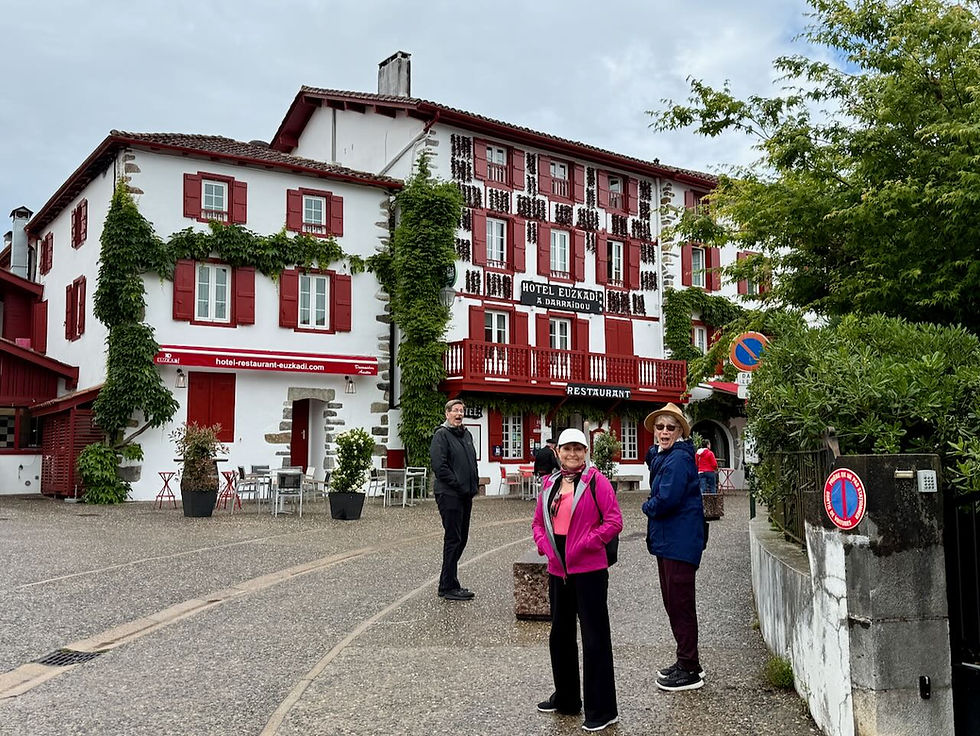
Out of the car and into the traditional Basque town of Espelette. The strings of drying peppers on the houses reminds us very much of Santa Fe, New Mexico.

Decisions, decisions. Time for a morning pastry.
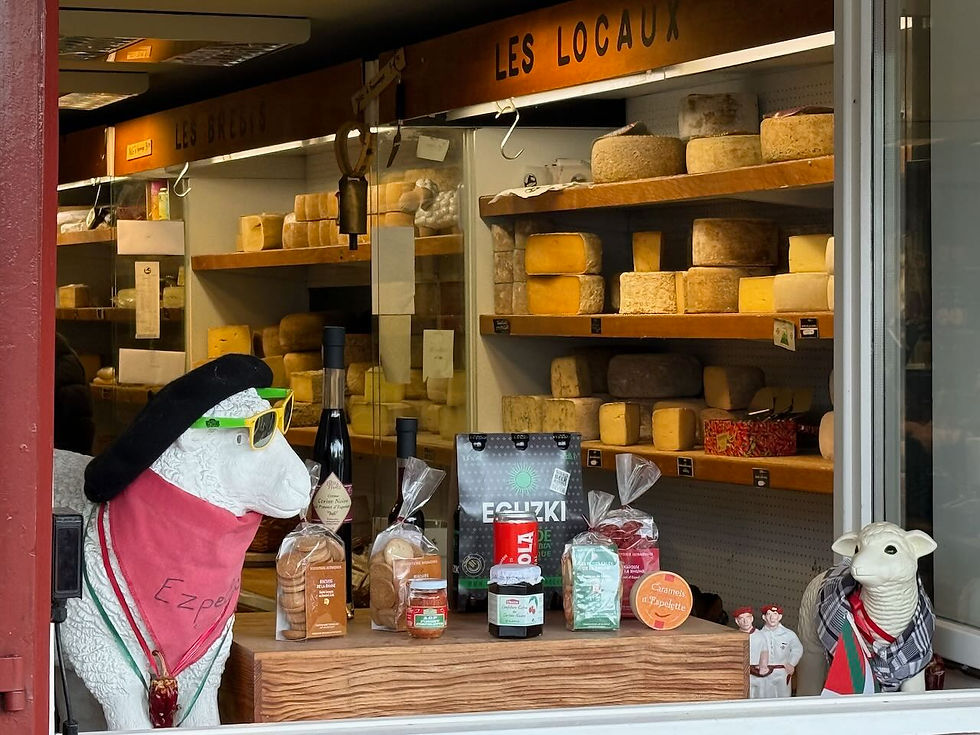
Next door a ceramic sheep, in traditional Basque attire, promotes the sheep cheese of the region.

Something they make is baked at a high temperature until it turns black. We haven't tried this yet (not sure we will). It doesn't look very appealing.

Speaking of not appealing, to gauge residents feeling on various issues (like this propsed building project) there's a box where you can "vote" with your cigarette butt to voice your opinion.

The region claims many things, including being the espadrill capital of (something).

At the local cheese maker's promotional office they help us normal folk know how much work it is to produce the delicious cheese their farmer's make. We'll take their word for it. It's a slow process that doesn't lend itself to 'watching'.
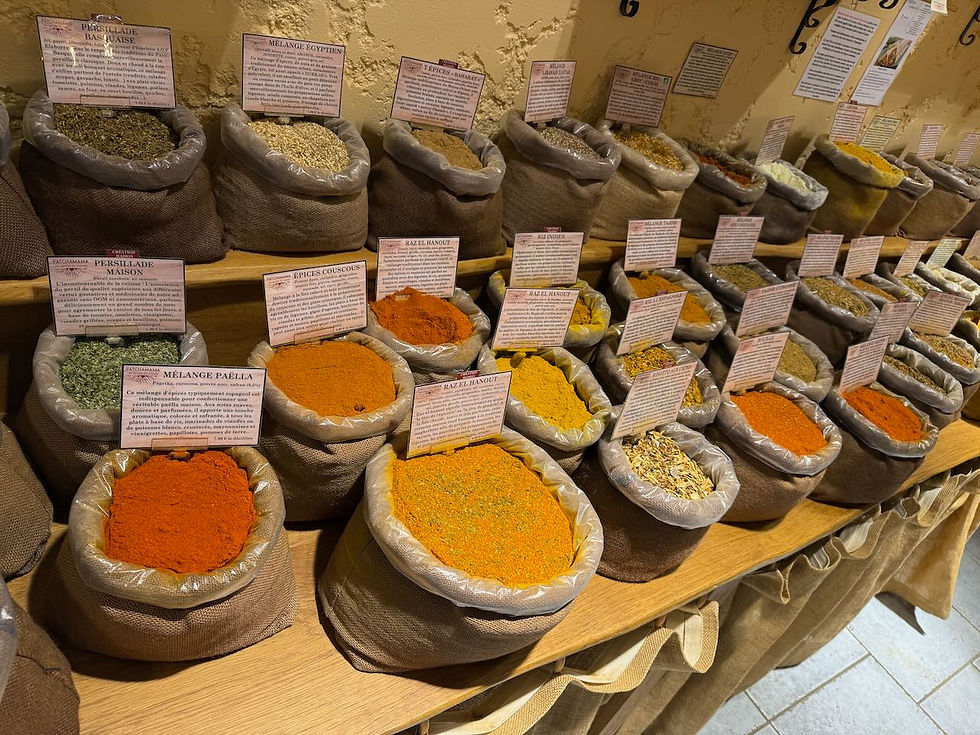
At a local spice shop, different herbs and spices and mixtures were out to be sniffed and purchased. It made the shop (and street out front) smell delicious.

We're not sure if it's by chance or law, but there was a Basque uniformity to the buildings in town.

At a cheese makers farm we sample cheese, only to be interrupted by the (recently sheared) sheep responsible for same said cheese, as they self-relocate from point A to point B.

In La Bastide Claraince we marvel at their town water fountain in front of the Mairie (the town hall). It starts at the top, flows down a couple of levels, and then goes just below the side walk way down to some more similar pools further down the hill.
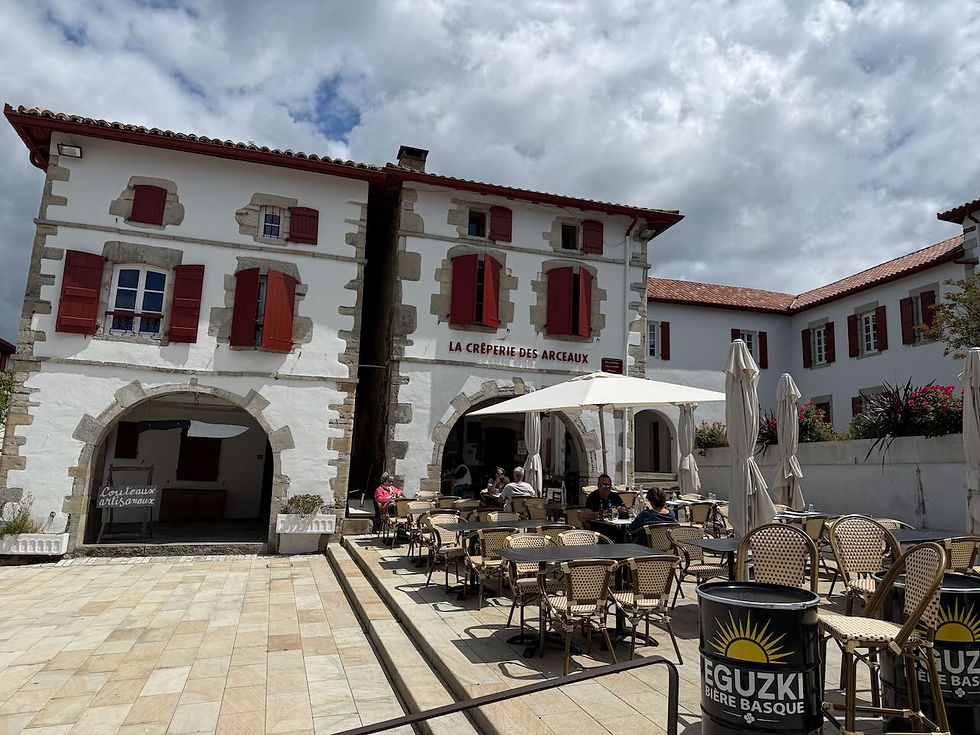
Across the street we find a good place for lunch, a crêperie. The fare was copious, and rustic, but (we gather) authentic.
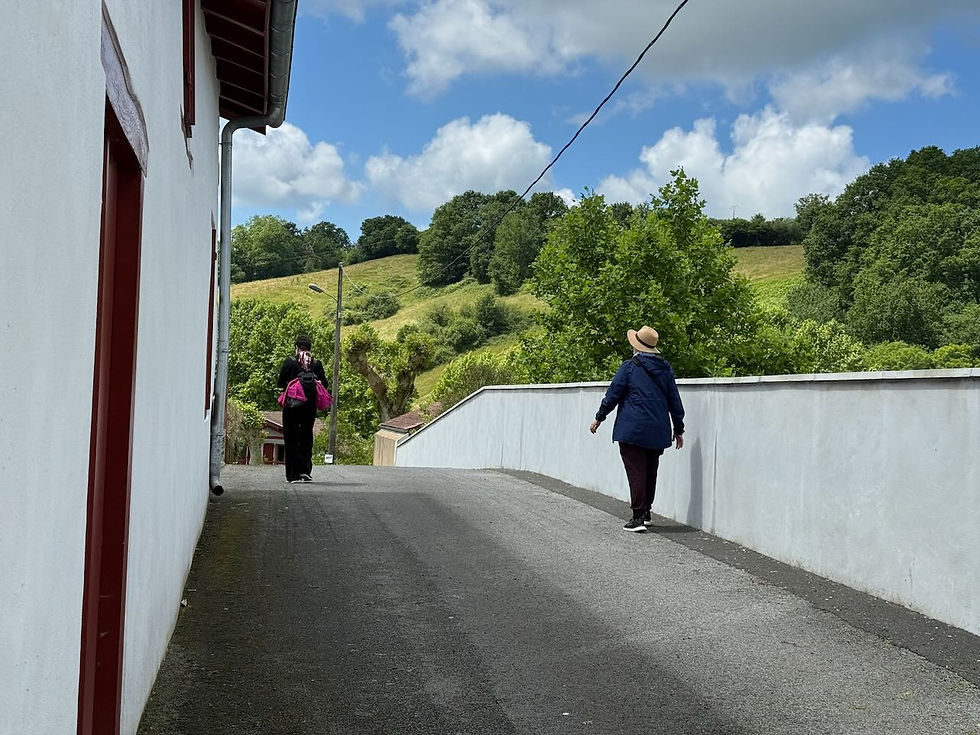
Much further down the street (and way in the back) is a local chocolate shop that makes their own chocolate. We get to sample a bunch and buy quite a bit.

Back at the hotel Karen and Ron chill by the pool.
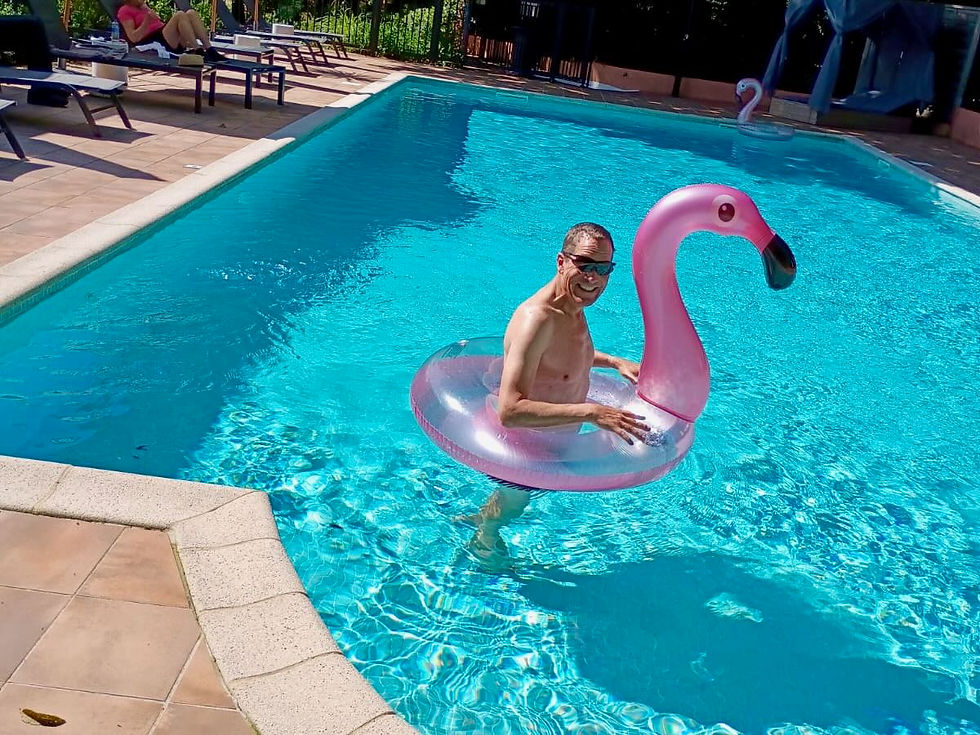
I get into the pool, albeit only half way, due to the cold water. It is chilly!



Comments